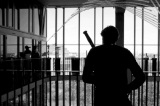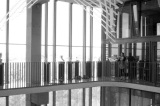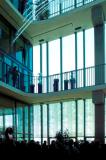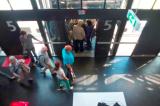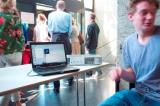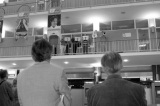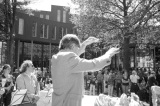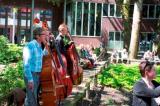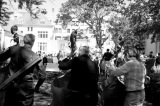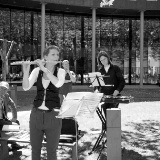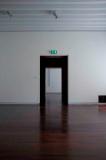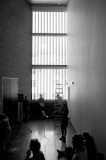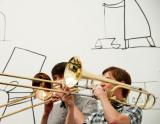A Sunday moring walk with Orkest Zuid
It was a lovely Sunday morning walk, a walk in which moving music, and architecture as movement, and the complete mutual dependence and reciprocal action of music in architecture, was revealed in a way I had not dared hope possible. Music and architecture are spatial and immersive arts and architectural space is an acoustic event as much as it is anything else. A building is an instrument and music reveals the intangible dimensions that shape a space and space shapes the music in its performance. The body receives the movement of music and responds in movement, it hears with its muscles and in moving it experiences architecture. In movement music heightens the relationship between the body and its environment, an event becomes architecture. I need to tell the whole story.
About a year ago I suppose, an old student of mine, Eefje Rikhof, mailed me to ask whether we could talk about a project she was involved in with her Orchestra: Orkest Zuid. We talked, together with the conductor Jos van de Braak, the great engine behind their enthusiasm. They wanted to explore the spatial nature of music for their next performance-project and had heard I was doing an investigative design project on just that subject.
That was then. Last Sunday saw the culmination of the idea in an event: a walk through space, into music. We got the students of Anarchi involved and the lot of them under the capable leadership of Rutger Brouwers and Kenny Vonk did a fabulous job. It was a truly wonderful day, well-organised, a real pleasure. But it was also more than that, it was something of a revelation. You don’t get many of them.
Their idea was simple: two pieces of music, each played three times in specific places and spaces during a comfortable walk from the faculty building, through the railway station to the Van Abbe museum, stopping at two further places on the way, a modest, enclosed park/garden in the centre of town and the Design House, which used to be the district court of justice.
A piece called Canzone for two choirs of brass players by Giovanni Gabrieli was played by the brass section of the orchestra in the faculty building, the station and the museum, while a piece called The nature of things by Henry Brant was played by the wood section in the atrium of the faculty building, the park and the Design House.
The choices were carefully made. Giovanni Gabrieli, a Venetian composer of the sixteenth and early seventeenth century is by many credited with being the first to deliberately explore and exploit spatial location in his music with polychoral settings. Having said that some ascribe the invention to his earlier colleague at St Mark’s, the Fleming Adriaen Willaert. In any case it was the peculiar arrangement of the Cathedral’s spaces that allowed them to play with the positioning of voices in space. Judging by the design of the Cistercian abbeys and the occasional use of Vitruvian amphorae to improve the resonance so eagerly sought after in the slow musical cakewalks of Gregorian chant, I would hazard a guess that the conscious use of space as a musical device is almost as old as music itself, but what Garbieli or Willaert did was slightly different, they played both music and its space and played with both in relation to each other. A particularly well known example of Gabrieli’s approach is a called In Ecclesiis, a title that appears to hint at the relationship between the church as a building and the music it fills.
Henry Brant had been told about Gabrieli by a friend of his and felt inspired to devote much of the rest of his composing life to the idea of spatiality. And so The nature of things explores spatial location and hearing.
One hundred and sixty people turned up which was encouraging. We were introduced to the project, given the itinerary and treated to a first version of the Gabrieli. It was lovely. The real magic happened upstairs in the over-acoustic bathroom that is our atrium, where we were treated to the Henry Brant. To understand it I have to give you a description of the atrium.
The building used to be the old chemistry faculty. That means it had high floor-spaces to accommodate all the air filtering devices and other laboratory equipment that such places need. It was refitted during the nineties to become the new faculty of building in 2002, which is when I first started teaching in Eindhoven. So, you have a sixties concrete skeleton with slab floors nine stories high, each storey some five metres high. From the fifth floor upwards the architect Bert Dirrix had an atrium sawn through the concrete floors on the west side of the building, all the way up to the top. Mezzanine floors were inserted from the sixth floor upwards on two opposing sides, to accommodate small office cubicles stacked eight (half)storeys high to face each other with floor to ceiling windows. The third side of the atrium, set against the façade of the building, became a single, huge 25 m high window overlooking Eindhoven. The atrium has become the theatre of our working lives. When talking on the phone to someone in a cubicle on the opposite side, we look at each other and gesticulate madly as if we need to bridge a vaccuum to convey our meaning. A person in the atrium on the other hand need only whisper and the whole space comes alive with reverberation.
The conductor had the members of the ensemble arranged on the fifth, sixth and seventh floors. Because of the 160 people and the members of the orchestra all crowded into this tall slender space, the acoustics dampened and we were treated to a beautiful and rather spiritual piece of music somehow appropriate to a cathedral. The percussion far away, a flute far away, a hobo far away and then a group of clarinets and the bassoon close by. The huge window over Eindhoven, and the shuffly noises of people adjusting their weight, clicking their near silent cameras and working away an occasional sneeze or cough all made things bigger.
On the way up, students under the guiding hand of Toon Rooijmans, who had worked out the idea during our music and architecture project of a year ago, played the first spectacular upward crescendo of Verdi’s Requiem to accompany the lift as it pierced through the roof of the adjoining building on floor three to emerge from the dark shadows of its own shaft into the unbearably bright light of the south facing sky. Now, on the way back we were treated to downward music, to Mozart’s Don Giovanni singing his final way to hell.
As we passed out of the building we were the guinea pigs of an experiment organised by Gijs Burg, who, together with his team, had recorded the performance of Brant in the atrium, played the recording in the elevator lobby on floor five while people were waiting to go down and simultaneously recording the result. This second recording was then played and rerecorded as people walked through the first floor lobby to be played one last time as we all descended the stairs to reach the exit. Each time the music was played it became increasingly deformed, ending up in a growling gastric gurgle that accompanied us as we emerged into the pleasant sunshine of a late Sunday morning in early June.
We entered the great hall of the station with its strong character of intense characterlessness, a fifties post-war reconstruction building which had been designed to look a little like a Philips radio of the same period. It has now become a state monument, which is interesting. Together with the people buying their tickets, meeting their loved ones or rushing towards the trains, we were treated to a pneumatic spatial gale of the Gabrieli, which it had to be said sounded like the end of the world: a great solid gelatinous block of sound in an echoic hall, usually only half-filled with the amplified drone of apologetic ladies announcing delays, the loud resonant clicks of heals and things shutting, the applause of running feet and the roll of small suitcase-wheels as people go about their daily station-business.
Now imagine a small urban park, enclosed by walls and offices, people sitting themselves in the sun, on the grass, on the benches and in the shade of the large trees clustered here and there. This time the musicians were further dispersed, set among the audience but all of them with a direct view of the conductor, whose sense of timing and pitch is trained to extraordinary sensitivity. The strollers quieten down and prepare themselves to listen to the same piece of music for the second time. Listening to the same piece of music three times during one morning, is that a good idea? I had my doubts. But they vanished on hearing the first tones. Whereas the first performance had been cathedral-like and overtly spiritual; here the sound was dispersed into the city and the city and the park responded in kind. The city with the drone of cars and the roar of a manly motorbike and an occasional call, the park with a breeze through he leaves high up in the upper crown of the tallest trees which were just about high enough to catch a slice of it coming over the roofs, and a finch who insisted on joining in the fun with his constant and ladder-like call. Spatially the music was more complex than before. The conductor noticed he had to adjust his timing because of the increased distance between the payers. And yet the whole had the quiet and comfortable air of a Sunday picnic, a pastoral, which is hardly surprising as the sounds behave as they do in a park, which is where you have picnics, they disperse upwards, are absorbed by the plants and the soft ground, and, because of the walls enclosing the park, return only here and there. I had not expected the intensity of the difference. I held my breath during the long rest interval towards the end of the piece. I had not expected to be listening to a completely different piece of music. I had only a few Brant CD’s at hand in my preparations, CD’s and my installation. They flatten music mercilessly. I had listened carefully, but had felt no particular enthusiasm for the music. And then came these performances. Now I am a big fan, I was moved, by the music and by the event.
After this performance it was my turn to do my bit. I talked about Lucretius. It had been fun re-familiarising myself with him over the weeks. I have to confess, before the project I had no more than a vague and shamefully platitudinous idea of De rerum natura, that it was an epicurean didactic poem et cetera. I had read the standard fragments. But this time I came prepared I had read several translations, English ones, Dutch ones and have fallen in love with it, particularly the metric translation by Aeg. W. Timmerman published in the eighties and the new translation by P.H. Schrijvers. I also chuckled over R.E. Latham's‘s introduction to the Penguin edition. So I talked about religion and fear and Lucretius’ well-meaning evangelic attempt to banish fear by removing religion. I speculated that it was fine to wish religion gone when it is everywhere and all we have; when it is the main and most visible cause of misery. When Brant took up the theme in the fifties and sixties it may still have been an optimistic hope, but there is also the complementary fear of the emptiness of a godless world. That world then needs to be filled with the divine, with beauty and truth in the quest for the good. That is where music and architecture come in. Without going too deeply into the finer point of Lucretius' explanation of perception with the theory of thin atomic films of sound emitted by the object and dividing and distributing themselves equally among available ears, I asked the people where we could find music. Where does music happen? I asked them whether music could be found on the sheet-music used by the musicians. A surprising number of people put up their hands. I then asked them whether the sheet-music did not need a musician, a skilled practitioner and a musical instrument, made with skill and a musical performance to make it music. And they agreed. And then I asked them where they could find architecture, where architecture happens. And I asked them whether the building is the architecture. Again a large number put up their hand thinking just that, that the building is the architecture. And I asked whether we did not need to have a relationship to the building for the building to reveal its architecture, whether we did not need to move through it or past it, whether we did not need to receive the building with our acquired skills in negotiating space and appreciation in order for architecture to happen as a special moment. Whether in fact the movement through the building was not just as much of a performance as a musician bringing us the movement of his music to allow us complete immersion in it. They agreed. And I told them that a beautiful building is only half the story and that the other half is within us, that a building is only ever as good as the person’s ability to undergo it well. And that was that.
We walked on to the Design House and there heard the third and final version of the Brant. Within the dark and somewhat formal sobriety of the hall, formed by four separate blocks of office space and courtrooms arranged around it and covered by a single roof. It became the most forlorn and melancholy version of the piece, which now began to sound familiar like an old friend.
It was a lovely walk.
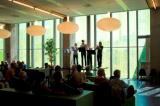
Gabrieli in Plaza, Vertigo
These photographs were taken by
Kenny Vonk and Rutger Brouwers.

